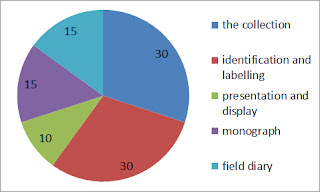You can read the official guidance on the marking scheme on Blackboard. This is the basic structure:
You can see that you're going to pick up a lot of points merely by getting organised early and doing the things the guidance asks you to do - it's not some subjective number plucked out of the air, so make sure you're following, and it you can get a high mark!
The 30% for 'the collection' means you'll be assessed on the quality and quantity of your specimens. Keep collecting throughout the year and you will get lots to put in - try not to leave everything until the last minute. People often ask how many they should submit, and I've written some thoughts here. Choose specimens that are undamaged and show the critical diagnostic features. Preserve them in a manner appropriate to the group you're collecting.
With 'identification and labelling' you can easily pick up marks just by including all the essential what / where / when / who information. Of course, accuracy of identification is very important! But if you collect a wide variety specimens you may be able to afford leaving out any you're unsure of. It's better to submit fewer specimens which are identified correctly, than loads of which half are wrong.
Presentation and display only offer 10 marks - but if you can be neat and set your specimens out taxonomically, clearly and attractively, it's surely an easy 10 marks? If your handwriting is illegible (or even if it's not) you can print your labels. I've tried to offer some advice about ways to display your specimens in the information about each taxonomic group. You can go down the traditional route or let your imagination roam.
The official guidance sets out in detail what should be in the field diary and the monograph- if you make sure you follow its advice, you will get marks accordingly! As I've said elsewhere, the field diary "only" gets 15% of the marks. But recording things in it diligently will pay dividends when you come to identify and label your specimens.
Just a small word of caution - some of the group-specific guidance on Blackboard is quite 'vintage' so be aware that some identification books recommended may have been superceded... I hope I've given you some more recent ideas on this website though.
Subscribe to:
Post Comments
(
Atom
)


No comments :
Post a Comment